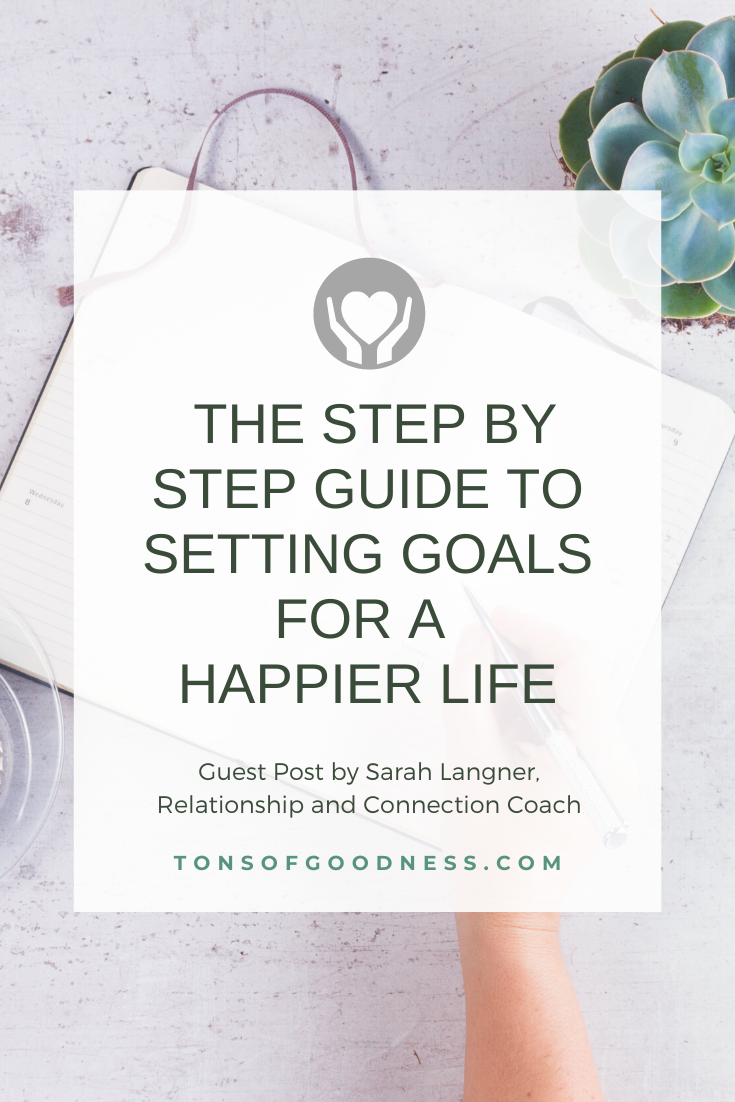

Disclosure: Some of the links in this article are affiliate links, which means that if you purchase through those links I will receive a small commission. For example, as Amazon Associate, I earn from qualifying purchases. If you decide to use these links, thank you!
Guest post by Sarah Langner, a relationship and connection coach. She serves her clients by guiding them as they strengthen the relationships that matter to them. She supports them as they discover who they are, their deeper purpose, and she keeps them accountable as they make the changes they want in order to live their life according to their deeper purpose.
I get it! You want to be happier. You want to be healthier, and you want to accomplish your goals. You’ve been told that setting goals improves relationships, increases contentment, motivates us, and overall improves life satisfaction. But for some reason setting goals leaves you feeling frustrated and sad because you never seem to finish those goals. You want to lose weight, but end up 5 lbs heavier. Or you want to become the Mary Poppins mom, but every day starts and ends with yelling. You feel worse about yourself than before you set the goal.
But what if you accomplished the goals you set for yourself? What if you achieved whatever you set out to achieve? You would feel happier, more successful, and actually improve your relationships because you’d know you could accomplish anything!
If you want to be happy, set a goal that commands your thoughts, liberates your energy, and inspires your hopes.
~ Andrew Carnegie
There are six basic steps that go into accomplishing goals that lead to a happier life. Below you’ll find each step, why it’s important, and how to work through the step.
The first steps to success are understanding where you are and where you want to go. Then plan how to get from where you are to where you want to be. Create milestones to check in with yourself. Then complete the goal, and finally assess the overall process.
If one of the reasons for setting goals is to have a happier life, then it’s important to understand how happy you are now. The problem with this is mood changes from one moment to the next. You may feel happy overall, but if, at this moment, you feel blah, then your rating will be skewed.
The way to prevent this from happening is to change ‘happy’ from a mood into something measurable.
What does happiness mean to you? How do you know if you’re happy overall?
Once you define what happiness means to you, then you can rate how happy you are overall. On a scale of 1 to 10 with 1 being not happy, and 10 being fully and completely happy, how happy are you?
Step two is to set your goal. The right kind of goal is important.
A goal needs to be SMART: specific, measurable, achievable, relevant, and time-based.
Maybe you want to write a book or get healthier. The specific goal doesn’t change these steps. What does matter is that it has a clear definition of done, you can clearly define progress, the goal is achievable, it is important to you, and has a clear time when you plan to be finished.
For example, If you want to write a 100 word book in one month, that might be achievable. However, if you want to write a 100,000 word book in one month, that’s just not doable at all.
You then need to know when the book needs to be completed and also what complete looks like. A complete book might be 100 words with pictures, or it could be 100,000 words and no pictures. How will you know the book is done? Do you want to have the words on paper/typed, or do you mean edited as well? Is it done after you submit for publication or is it done when you type the last word?
Click here to view and print a SMART goals worksheet.
Once you know what your goal is and when it needs to be completed by, then you can break it down into easy to achieve steps.
For example, if you want to write a 100,000 word book in one year, then create small steps within your larger goal. Some people might break it down into words per week or month, others might break it down into chapters. How you break it down needs to be attainable and make sense to you.
When planning the steps to your goals, it’s a good idea to write down the steps to your goal and when you want to complete them by. It’s easier to stay on track when you’re clear on what you need to do.
These check-in times have two very important functions. One is to gauge how well you’re accomplishing your goal, the other is to rate your overall happiness and satisfaction.
Setting your check-in times for partway between each step, and then at the end of each step helps keep you on track.
The best way to stay on track is to ask yourself each day you plan to work on your goal, “Did I put my best effort toward completing this task today?”
Scale your response. On a scale of 1 to 10 with 10 being your best effort possible.
Sometimes life happens and it’s not possible to move toward your goal on a specific day. When you understand that you put your best effort possible toward your goal, then it’s easier to be content with not moving forward. However, when you’re procrastinating, and not getting anything done, then that question can help motivate you to put in more effort toward your goal.
The other part of checking in is to rate your overall happiness. Think about how it has it changed since you set your goal.
I know you’ll love this step! Complete a goal and feel amazing! Check off that box and celebrate! Even if the goal was a small one, it’s worthwhile to celebrate completing it. Everyone loves acknowledgment, especially from ourselves.
Rate your overall life happiness/satisfaction again. On a scale of 1 to 10 with 1 being not happy, and 10 being fully and completely happy, how happy are you? Compare how your happiness changed while you focused on completing your goal. What do you notice?
Once you’ve allowed yourself time to celebrate, look back over your process and notice what worked well. What did you do that helped keep you on track? How did you help yourself move past any obstacles that came up? What do you notice about when things didn’t go smoothly?
These questions help you understand yourself better, and if that specific goal is something you’ll repeat in the future, you’ll have an even easier time succeeding when you know what already worked well and what could be even better.
Accomplishing goals leads to overall life satisfaction and happiness. Understand how to create goals you can clearly define when you complete it. Then break those goals down into manageable steps. Work through the steps, noting your progress, and celebrating your wins.
Happiness is a habit, but it’s the kind of habit that comes from meaning. When you place that meaning on goal completion, then make sure you’re capable of completing your goals!

Sarah Langner is a relationship and connection coach. She serves her clients by guiding them as they strengthen the relationships that matter to them. She supports them as they discover who they are, their deeper purpose, and she keeps them accountable as they make the changes they want in order to live their life according to their deeper purpose.
Sarah is married to Ryan, together they have 4 children, 3 cats, and an extra-large dog named Moana. She’s also a cancer survivor, a wire sculptor, a gardener, a fibre artist, and loves all things Disney.
You can find more from Sarah at A Great Big Beautiful. Connect with Sarah on Facebook and Instagram.
Thank you, Sarah, for sharing these empowering tips about goal setting.
What is your SMART goal? Let us know in the comments!


